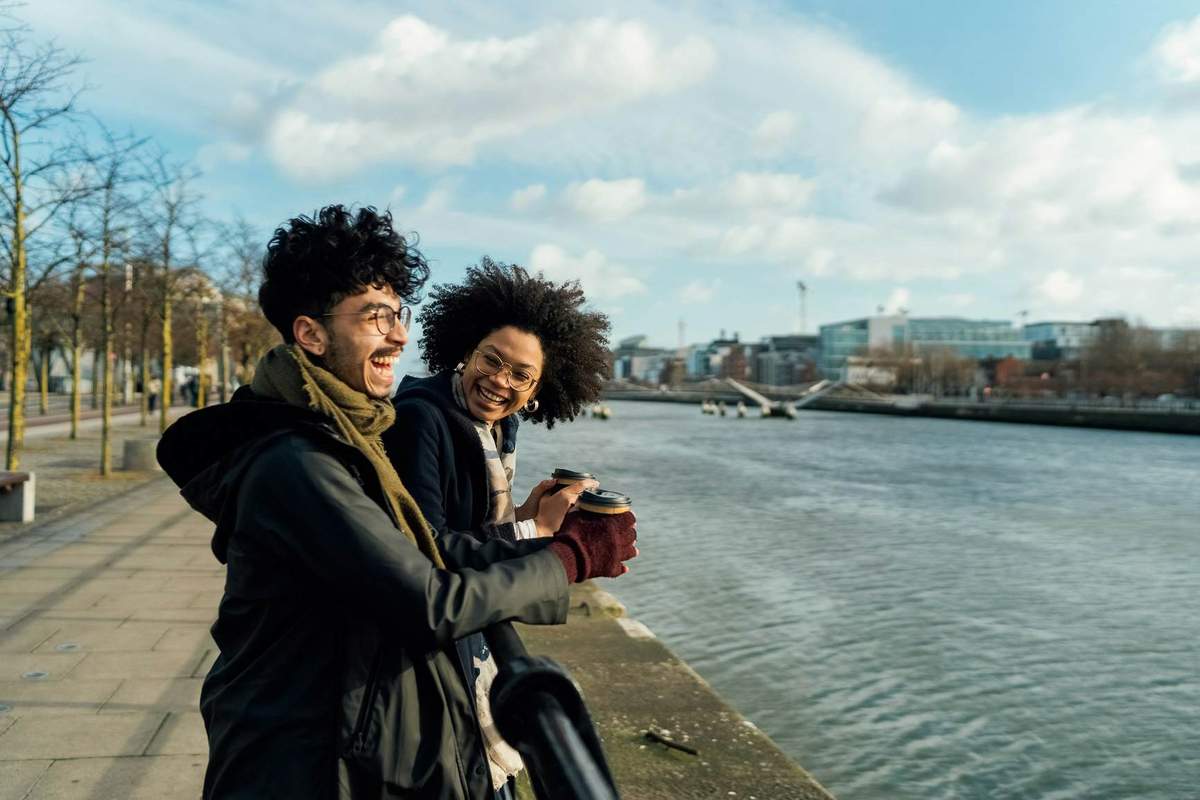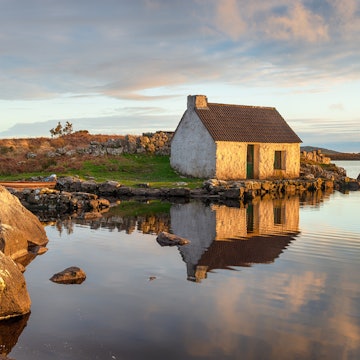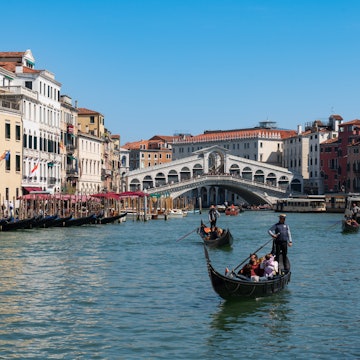
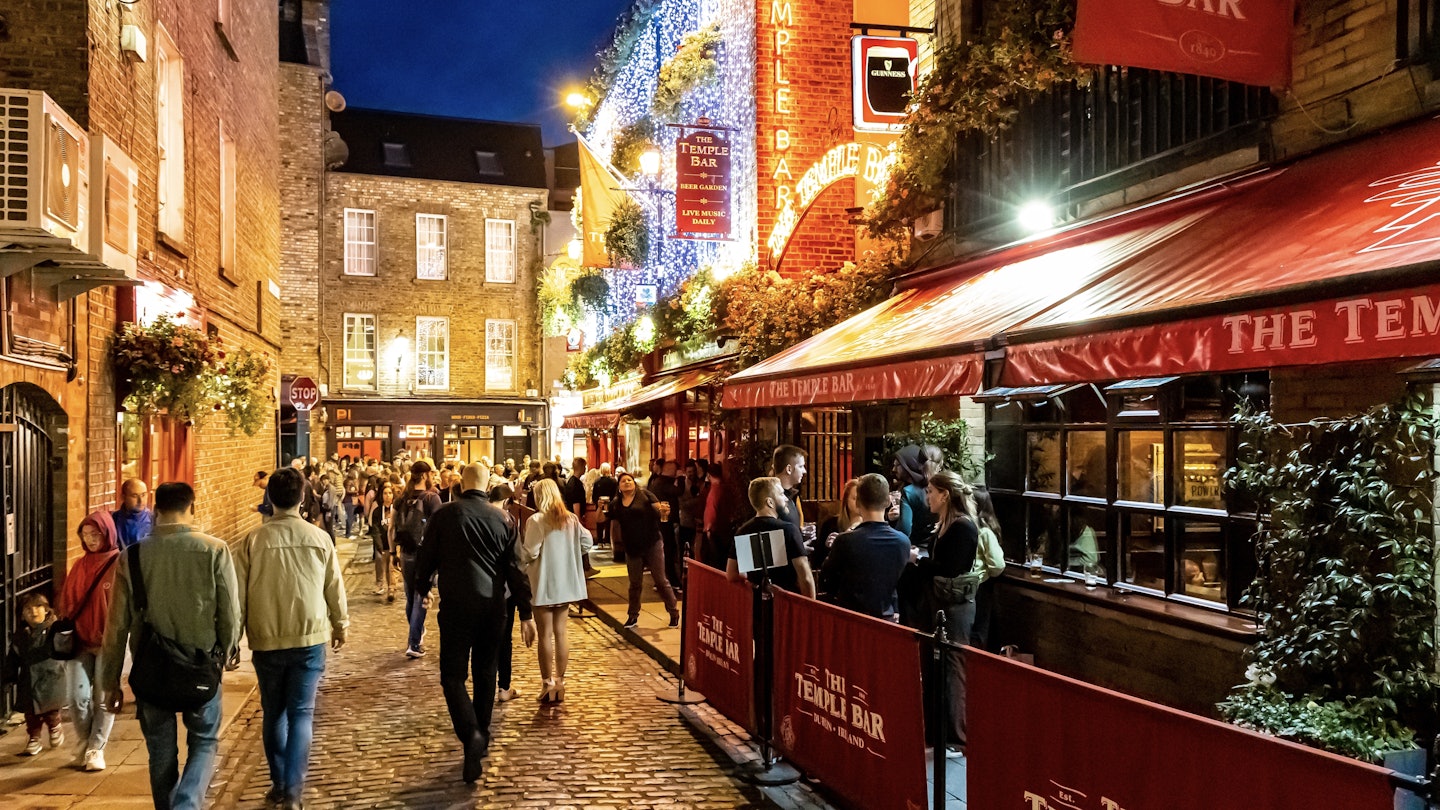
The evening scene in the Temple Bar district, Dublin. Alexey Fedorenko/Shutterstock
As a born-and-bred Dubliner, I’ve spent most of my life trying to make sense of my hometown.
In this lively, lovely city, it’s true that you’ll get your bearings quickly as you realize that you can explore most of the compact center on foot. Yet spend a few days in Dublin and you’ll soon appreciate that there is much going on in this busy little town – and that to really understand the place, you’ll have to move here and spend the rest of your days figuring out its wonderful idiosyncrasies and multilayered sense of humor.
Before you consider that major life change, start with our roundup of pointers designed to smooth your introduction to a city that has the power to grab your imagination – and not let it go.

1. Count on at least three days in Dublin
While Dublin is small for capital city, it will gladly take as much of your time as you can spare. You’ll need at least three days to even make a dent in the place. You should devote a whole day to a couple of major sights, such as Trinity College and the Guinness Storehouse. You’ll need another day to visit some of the city’s other brilliant attractions, like the Little Museum of Dublin, the Chester Beatty and the National Museum of Ireland (of its three Dublin locations, we’d recommend the archaeology branch). And a third day to sample some whiskey and visit either of the city’s iconic cathedrals.
A couple of days more will give you a chance to stretch your legs and get out into more of the city – such as the historic General Post Office and 14 Henrietta St on the northside. But you’ll have to build in some leisure time: after all, there are 800 pubs in the city, a fine selection of music venues and a handful of great theaters. And consider going further afield, on a day trip to Howth, for instance – or beyond.
2. Dublin is a casual kind of place – so pack accordingly
You can wear pretty much whatever you want in Dublin, with smart casual the dressiest dress code you’ll need (for fancy dinners, the theater or the concert hall). Even most work places like to keep it casual, since there’s a general perception in the city that dressing up is only for that special occasion – which work rarely is.
Irish summers are warm but rarely hot, so you'll want an extra layer for when the temperatures cool, especially in the evening when the disappearing sun can make that day’s warmth feel like a distant memory.
Ultimately, the ever-changeable weather will determine your outfits. A light waterproof jacket (preferably with a hood, unless you’re carrying an umbrella) and waterproof shoes should never be beyond reach, as rain is almost inevitable.

4. Get a Leap card for use on public transport
If you’re planning on using public transport in Dublin, start by buying a Leap Card, which you can buy at any newsagent. You can then tap it to pay fares – discounted fares! – on buses, DART, the Luas light-rail system and commuter trains throughout the county. The Leap Visitor Card (one/three/seven days; €8/€16/€32 / US$8.70/17.40/36) provides unlimited travel on public transport. You can buy one in the city and at Dublin Airport, or order one online to have delivered to your home ahead of your trip.
You top up your card (there’s a minimum of €5) at newsagents; any Luas, DART and commuter rail machines; or by downloading the Leap Top-Up App (just hold the card to the back of the phone to top up, collect prepaid tickets and check your balance).
If you’re using a regular Leap card rather than the Visitor Card, the TFI 90 Minute Fare applies to journeys made by Dublin Bus, Luas and most Dart trains. Any journey under 90 minutes (including transfer times) costs €2 (US$2.17). Note that for Luas, rail and DART services you’ll have to tap your card when you end your journey, in addition to when you begin it.
4. Take advantage of discount cards
A range of discount cards will save you money on attractions and transport. The GoCity All-Inclusive Pass (one to five days; €79–149 / US$86–162) gives you free entry to a bunch of top attractions, including the Guinness Storehouse, EPIC The Irish Emigration Museum, the Jameson Distillery Bow Street and the Big Bus Hop-on, Hop-off tour. For 25% off six top attractions, there’s the DoDublin Days Out Card (€55 / US$60).
In addition well as the Leap Card, you can score transport discounts with the DoDublin Freedom Ticket (€49 / US$53), a 72-hour travel pass that covers all public transport as well as a hop-on, hop-off tour.
5. Uber is not the best rideshare option in Dublin
There are plenty of taxis in Dublin – but they can be tough to find late at night, especially on weekends, when thousands of Dubliners are looking to head home to the suburbs after a night out. While Uber does operate in Dublin, it’s notably expensive. By far the most popular rideshare app is Freenow, which you can use to call a city taxi. There are taxi stands in the city center, but hailing them through the app is the preferred (and most convenient) option for most.
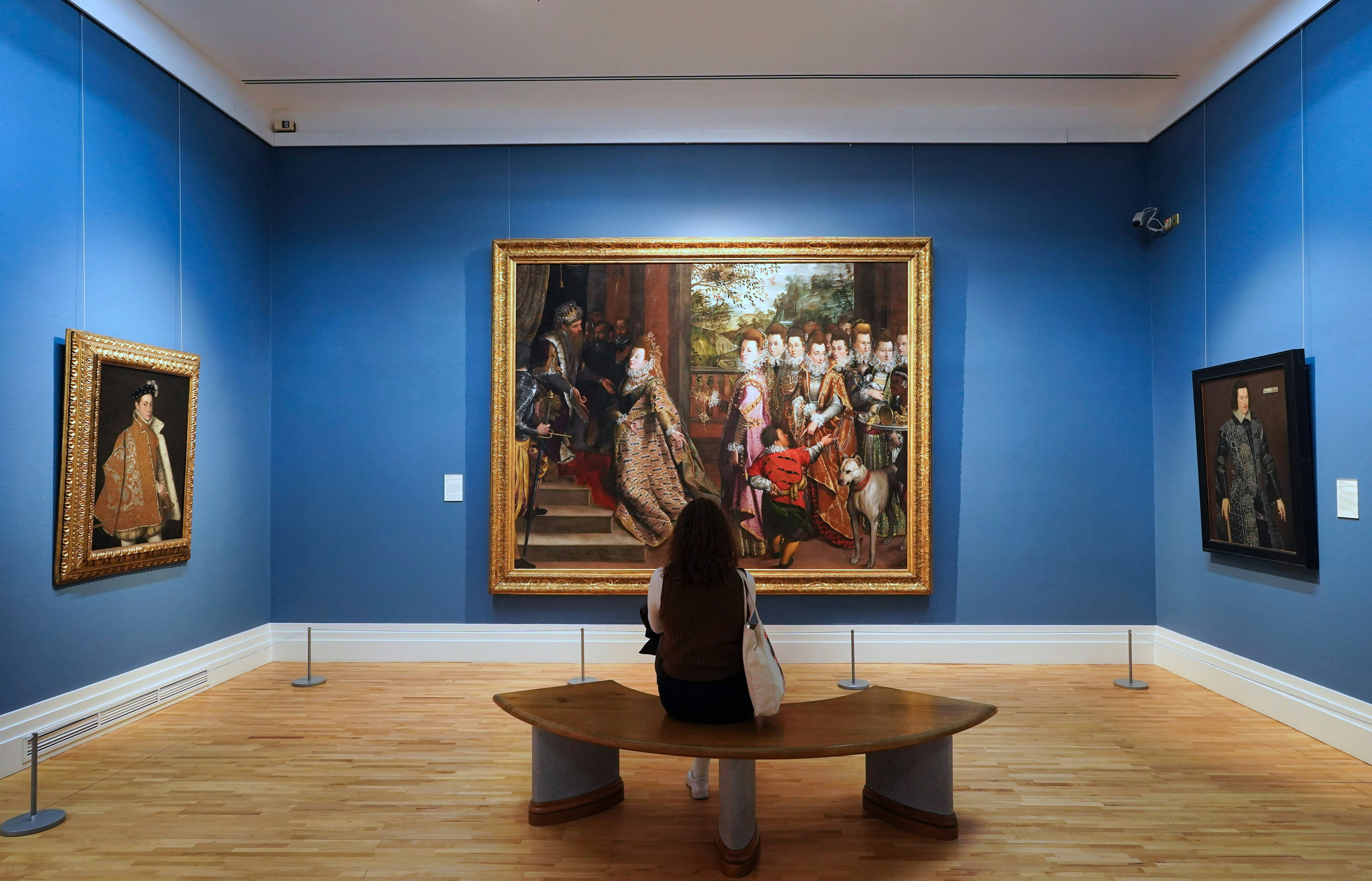
6. Many of the city’s museums are free to visit
Most of the city’s larger cultural institutions are free to visit, including the National Museum of Ireland (which has three Dublin branches, though as of spring 2025 the Museum of Natural History is closed for renovations), the National Gallery, the Chester Beatty and the Dublin City Gallery–the Hugh Lane. (Note that certain exhibitions do require a paid ticket.) There are free tickets for the tours of Áras an Uachtharáin, the official residence of the Irish president in Phoenix Park; and and there is no charge to visit the Irish Museum of Modern Art in Kilmainham.
Smaller, privately owned museums charge a fee – but it’s rarely more than €10 (US$10.85), and you won’t need to book your ticket in advance.
7. Learn the ins and outs of Dublin dining
Dubliners rarely eat breakfast out, so you might struggle to find a decent spot for breakfast before 9am or 9:30am. The good news is that a decent cup of coffee is non-negotiable, so there are plenty of places open by 8am to cater to java-jonesing workers.
Discounted lunch specials are common, especially in the busy city center. Book tables at popular restaurants at least a few days in advance if you want to avoid disappointment or that dreaded 5:30pm slot. For the really fancy places, including those with Michelin stars, you’ll have to plan well in advance. Some (like Restaurant Patrick Guilbaud) will accommodate reservations no more than a month in advance; others (including Chapter One) take bookings three months in advance. Most tables are nabbed up pretty quickly – but if you miss out, you can join an online wait-list.
8. Dublin’s tap water is great
In restaurants, you should count on a carafe of Dublin’s safe, free and generally excellent tap water. (Some restaurants operate their own in-house filtration system, so for a euro or two, you might have your choice of still or sparkling tap water.) Same goes for filling your water bottle: tap is just fine – and spares you the personal and environmental costs of single-use vessels.

9. In the pub, it’s all about the rounds system
Like the rest of the Irish, Dubliners put great store in conviviality and a generous spirit. And both of these qualities are embodied in the rounds system: if someone buys you a drink, you are obliged to buy them one in return.
Embracing this practice is a great way to get to know Dubliners. Strike up a conversation, then, at the appropriate moment (ie when they’re just about to finish their drink), ask what they’re “having.” Before you know it, you’ll be multiple drinks and conversations deep into a blossoming friendship.
Needless to say, you don’t have to take part in buying rounds. But if you want to understand the social glue that binds people together in Dublin, there are few better ways than raising a few glasses with them.
10. Dublin’s nightlife will cost you
Dubliners love a good night out – and pay handsomely for the privilege. A pint of beer will run you €7–10 (US$7.60–10.85), higher than anywhere else in Ireland. Keep an eye out on pubs that sneakily raise the price of a pint later in the night, presumably when punters are too...distracted to notice. It’s illegal to charge a price other than what is indicated; if it happens, your best reaction is to complain and leave. Since happy hour promotions are illegal in Ireland, many Dubliners will have a few drinks at home before heading out, usually between 9 and 10pm.
Licensing laws are stricter in Dublin than in almost any other European capital. Pubs can serve alcohol only until 11:30pm Monday to Thursday, 12:30am Friday and Saturday, and 11pm on Sunday. Many premises apply for special exemption orders, which allows them to serve until 2:30am, usually on the weekends. Nightclubs can go until 3am, but in a lot of venues there’s barely a distinction between a huge pub that turns up the music really loudly and a dedicated club for dancing.
11. Learn to take a “slagging” among friends
For the most part, Dubliners are an informal and easygoing lot who don't stand on excessive ceremony and generally prefer not to make too much fuss. That doesn't mean that they don't abide by certain rules, or that there isn't a preferred way of doing things here. But the transgressions of the unknowing are both quickly forgiven and even enjoyed. And the accidental faux pas is a great source of entertainment in a city that has made “slagging“ (teasing) a veritable art form.
Indeed, slagging is a far more reliable indicator of the strength of friendship than virtually any kind of compliment – and a fast, self-deprecating wit plus an ability to take a joke in good spirits will win you plenty of friends. Mind you, even slagging has its hidden codes, and is only acceptable among friends. For even in Dublin, it wouldn’t do at all to follow an introduction to someone by making fun of them.

12. LGBTIQ+ travelers are most welcome in Dublin
Dublin has a pretty vibrant LGBTIQ+ scene, with some well-established bars and club nights as well as group clubs for such activities as hiking and sea swimming. The best-known gay bar in town is The George on South Great George’s St, followed by Pantibar, which is owned by renowned activist and drag queen Rory O’Neill (aka Panti Bliss). The second-biggest celebration in the city after St Patrick’s Day, June’s Pride Festival is a raucous festival of color and fun that runs over five days. August sees GAZE International LGBTQIA Film Festival, while the International Gay Theatre Festival usually takes place in May.
13. Dublin is generally a safe city, with good health care
Health and safety should not be an issue during a visit to Dublin. Pharmacies selling basic medication are numerous, and crime is not a major concern. Taking normal precautions (such as keeping an eye on belongings in crowds) should be sufficient as you explore. O’Connell St and the streets immediately around it can get a little shady after dark, so keep your wits about you.






